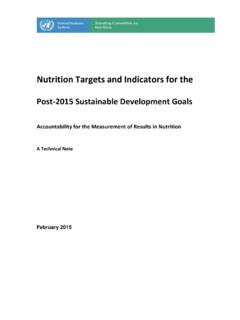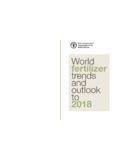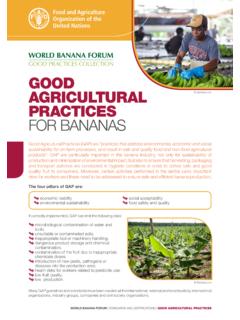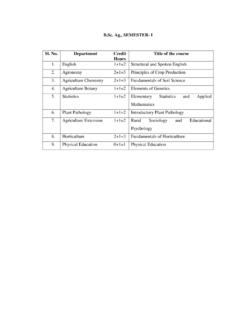Transcription of Nutrition and Agriculture - UNSCN
1 Agricultureand Nutrition are linked in many have long recognized the most obvious connec-tion food security is one of the three pillars of goodnutrition, along with good care and good health. In 1945concerns about recurring famines and malnutrition led to the establishment of the Food and AgricultureOrganization of the United Nations (FAO).The FAO was mandated to raise levels of Nutrition and standards of living, and improving agricultural productivity was animportant means to this , Agriculture is still seenas one of the foundations of national the past 55 years evidence has mounted showingthat agricultural productivity is a powerful force forpoverty reduction and economic development.
2 In recentdecades, however, a wide range of factors has hamperedgrowth in agricultural productivity in the least-developedareas. These factors include underinvestment in agricul-tural research and development, irrigation, ruralinfrastructure, and education, as well as the inability ofpoor farmers to get access to rich-consumer markets,whether in the developed or developing pathways through which Agriculture affects nutritionare well documented. Improved Nutrition in turn supportsthe Agriculture sector by enhancing rural people s abilityto undertake the strenuous tasks involved in small-scalefarming.
3 The links between improved Nutrition status andimproved work capacity and productivity are to enhance agricultural productivity and incomes, theagriculture sector must pay even more attention tonutrition. This increased attention to Nutrition by the agri-culture sector ensures a greater focus on the consumer,which is good for Agriculture from both a public goodsstandpoint and a private goods Agriculture s Impact on Poverty and MalnutritionAs the conceptual understanding of food security andnutrition has deepened beyond food production, the agri-culture sector has come under increased pressure fromgovernments in the north and south to demonstrate itsimpact not only on food output, but also on poverty andmalnutrition.
4 If Agriculture can increase its antipovertyand Nutrition benefits, it will likely garner greater supportas an important public good. This increased support islikely to lead to significant private returns to small-scalefarming via technology spillovers from improved researchand has already had a strong impact on povertyand malnutrition. The efficient, low-cost production ofNutrition and AgricultureARNEOSHAUG ANDLAWRENCEHADDADNUTRITIONA FOUNDATION FORDEVELOPMENTA FOUNDATION FORDEVELOPMENTB rief 6 of 12 Agriculture food staples such as cereals is obviouslyin the interest of the poor.
5 Because foodstaples constitute such a large percentageof people s food purchases and overallexpenditures, any reduction in theirmarket price will result in increases indisposable largest relativeincreases in income will accrue to thosewho spend the highest percentage of theirincome on food typically the poorest who can use these increases to purchasea greater range of foods. In high-povertyareas, there will be a stronger demand forlow-priced food staples from those house-holds that are net food consumers. Someof the income generated by efficient staplecrop farmers will be plowed back into thelocal nonfarm economy, which is of benefitto the wider community of is the Nutrition impact of lower staplefood prices overcome by higher prices fornonstaple foods?
6 Some countries haveseen rises in the real prices of vegetables,fruits, and animal products over the past 25years. These foods are particularly rich inmicronutrients and other substances thatare crucial to good health and humandevelopment. Are these price increasesthe result of insufficient investment in agri-cultural research and development inthese products? Or are they the result ofsome other supply side constraint? In theabsence of a Nutrition lens, these pricetrends might not be thought significant. Inthe presence of a Nutrition lens, agriculturalpractices and policies can be examined todetermine if Agriculture can have a largerrole in reducing micronutrient deficienciesand changes that enhance thenutritional content of food can also be ofbenefit to the poor.
7 However, much willdepend on whether improved foods retainother consumption traits (storage,cooking, taste, etc) that are important to the poor, andwhether they are more costly or Farmers Ability to MeetChanging Consumer DemandsBy seeking closer collaboration with Nutrition , agriculturecan gain new insights into the needs of its primarycustomer, the consumer, whether poor or is, of course, consistent with the private returnsthat motivate 1996 World Food Summit defini-tion of food security creates the space for increasedcollaboration between Agriculture and defi-nition is.
8 Food security exists when all people, at all times,have physical and economic access to sufficient, safe andnutritious food to meet their dietary needs and food pref-erences for an active and healthy life. The definition also strengthens the focus on the needs ofconsumers across different dimensions: cultural (prefer-ences), health (nutritionally adequate diet and safefood), and sustainability. This demand-driven perspectivecan be visualized as shown in Figure FOODSECURITY: A COMMONGOAL FORAGRICULTURE ANDNUTRITIONS ource: Definition of food security as used by the RoyalNorwegian Ministry of Agriculture , adapted from A.
9 Oshaug, Eide, and A. Eide, Food, Nutrition , and human rights, confer-ence paper for World Health Organization/Food and AgricultureOrganization of the United Nations (WHO/FAO) InternationalConference for Nutrition , Nordic School of Nutrition /NorwegianInstitute of Human Rights, University of Oslo, FOUNDATION FORDEVELOPMENTA FOUNDATION FORDEVELOPMENTAGRICULTUREB rief 6 of 12In the best interest of the consumerAdequate food supplyNutritionally adequatedietFood culture considerationsSafefoodStable food supply and accessFood securityEcologicallysustainableEconomica llyand sociallysustainableBut consumers also demand variety in their diets.
10 Drivenby various imperatives taste, prestige, personal identity, Nutrition , and safety consumers want access to a widerange of foods. If farmers are to sustain their ability togenerate income for themselves and to increase dispos-able income in the wider urban and rural economies,they will need to respond to these demands in a timelyway. A Nutrition focus will help them to do people s incomes go up, their demand for fruits, vegeta-bles, and animal products increases dramatically. Thisrise in demand is due to a combination of incomegrowth and shifts in taste preferences that accompanyaging and increased urbanization.












